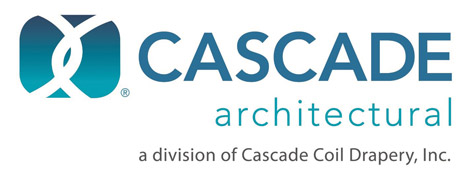This CE Center article is no longer eligible for receiving credits.
Hospitals and other health-care facilities have special considerations when it comes to the health, safety, and welfare of their occupants. Sanitation and cleanliness are of upmost importance. Residents and patients may be older or immune compromised, and thus more vulnerable to disease-causing pathogens than healthy people. In addition, health-care facilities often see a higher proportion of people with special needs when it comes to mobility and access. Care providers must be able to effectively perform their work. At the same time, the building design should ideally promote healing through design choices that create a warm and comforting environment. Finally, the building should be safe, secure, and easy to navigate.
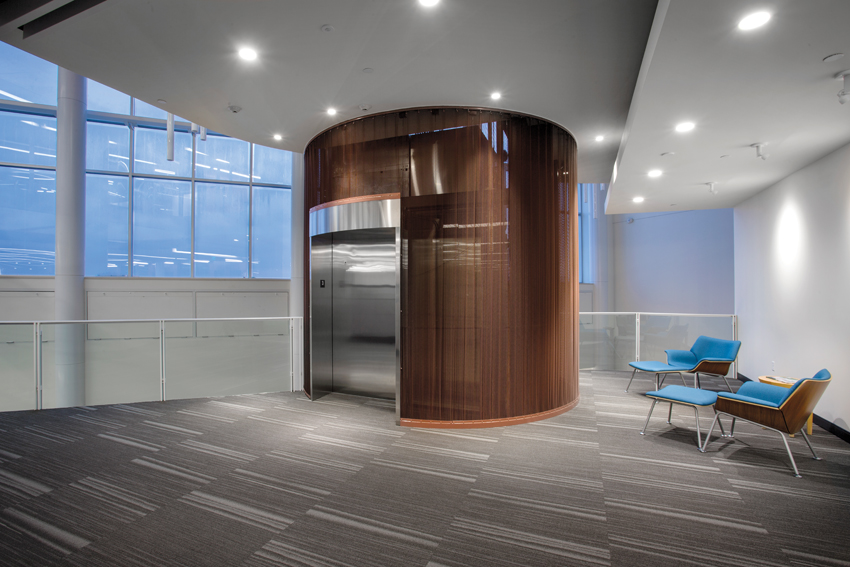
Photo courtesy Courtesy of Cascade Architectural
Coiled wire fabric was used as a visual design element and safety feature around the elevator shaft and stairways at the VGM Group’s Iowa headquarters.
The transmission of infectious disease is a serious problem in hospitals and other health-care settings. The COVID-19 pandemic has underscored the importance of mitigating this risk while also maintaining flexibility. Sometimes spaces may need to be rapidly reconfigured to accommodate an influx of patients. At the same time, staff must help prevent the spread of highly infectious disease pathogens. Together, these concerns drive nearly every design choice, from floorplan design and layout to lighting design and the selection of surfaces, finishes, and fixtures.
DESIGN FOR QUALITY CARE AND PATIENT SAFETY
Designers of health-care facilities must balance many factors: the safety, health, and well-being of patients; the effective delivery of care; the creation of a welcoming environment that promotes healing; energy efficiency; and the cost of maintenance and operation, among others.
A literature review conducted by several researchers in 2007 identified several design elements as critical for ensuring patient safety and quality care. These include strategies that help prevent falls, reduce the risk of cross-contamination, and enhance visual performance, among others.
Let’s look at a few examples of design choices that enhance accessibility, safety, and health in health-care facilities.
Wheelchair-Accessible Medicine Chest
Wheelchair-accessible medicine chests and mirrors can make a significant difference for someone with a disability. These Americans with Disabilities Act (ADA)compliant products are ideal for assisted-living facilities. One such medicine chest is constructed with an angled, LED-illuminated mirror that allows people with a lower viewing level to see their reflection. It also allows access to medications without assistance by allowing the user to lower the interior shelving down to a comfortable level. This innovative design addresses equity and safety—two key concerns in health-care facility design.

Photo courtesy of AAMSCO Lighting
Safe, accessible medicine storage is important to the health and well-being of residents and patients in health-care facilities.
Copper-Clad Wire Fabric
Copper-clad wire fabric is an innovative product that can be incorporated into building interiors as part of an overall design scheme or to temporarily partition rooms. The material is lightweight and will not interrupt airflow, an important consideration for ensuring airborne pathogens do not build up within a space. The fabric consists of pure copper metallurgically bonded to the surface of low-carbon steel wire. Left in its natural state, copper-clad steel wire has demonstrated antimicrobial properties, reducing the risk of cross contamination and enhancing the safety of health-care facilities.
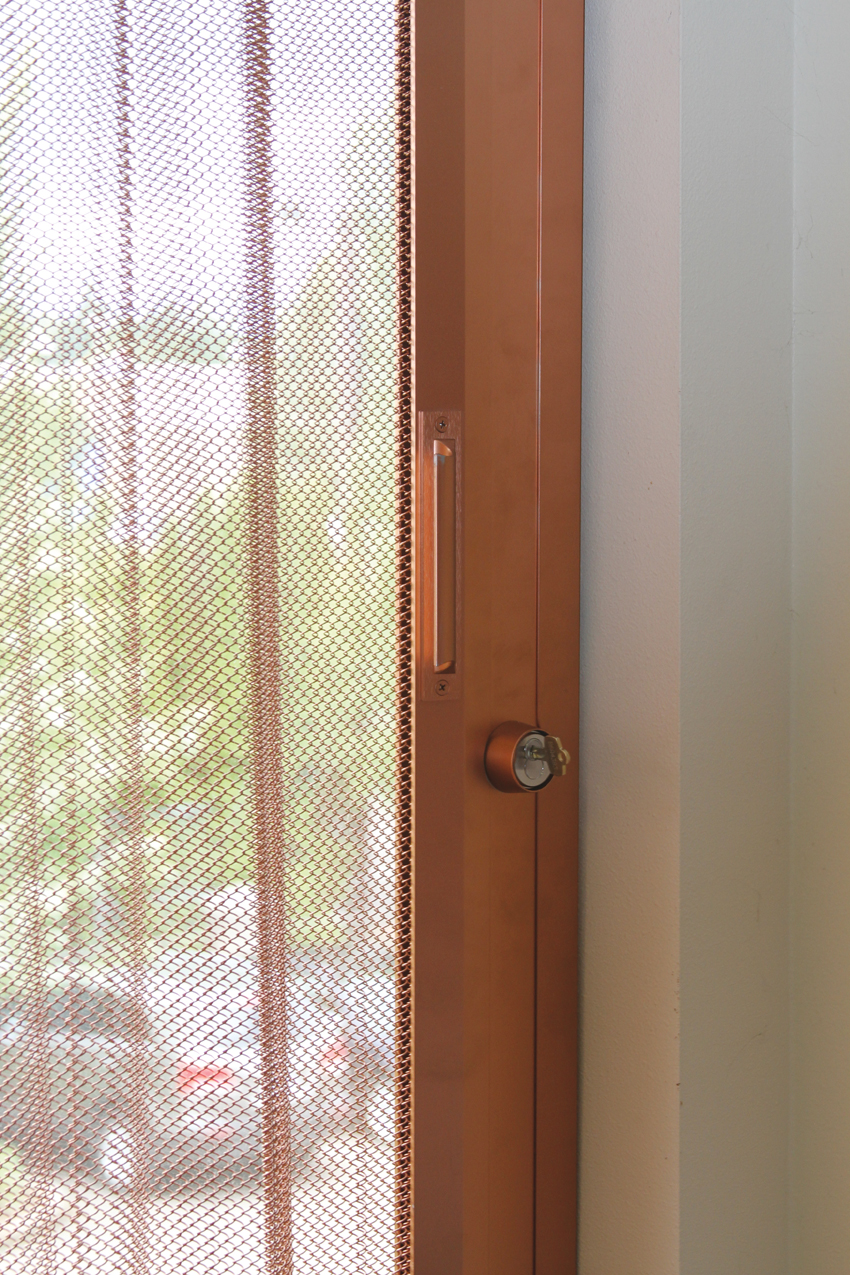
Photo courtesy of Cascade Architectural
Copper-clad wire fabric is naturally antimicrobial and can be used to divide spaces or provide solar and shade control.
Antimicrobial Privacy Curtains
Privacy curtains are often used to divide cubicles in emergency departments. Although single-patient rooms are preferred, privacy curtains are also used to provide privacy to patients who must share rooms. These frequently touched curtains can serve as a vector for disease organisms. However, fabrics that utilize silane-based technology have been tested and proven to be permanently antimicrobial and inhibit the growth of mold and mildew. These fabrics also repel liquids and are highly resistant to most stains.

Photo courtesy of Inpro
Privacy curtains can contribute to a safer, hygienic, and dignified health-care environment.
The rest of this course will consider design choices in several key categories: hygienic and accessible restrooms; the creation of hygienic, flexible, and healing interiors; materials and products that reduce the spread of contaminants via surfaces; and design choices for critical care environments.
HYGIENIC AND ACCESSIBLE HEALTH-CARE RESTROOMS
Restrooms offer a special challenge for health-care design. These rooms must be easy to clean and hygienic, but they also must be safe and accessible. Health-care facilities provide treatment for a higher proportion of people with physical challenges. These include physical disabilities as well as conditions such as obesity and age-related declines in vision and motor function. In addition, some patients and residences may suffer mental disorders that make them more prone to harming themselves.
As required by the ADA, all public buildings must be accessible for people with disabilities. This is especially important in hospitals and health-care facilities because they typically serve a much larger population of users with disabilities.
There are specific requirements for ADA-compliant restrooms that guide everything from how much weight certain fixtures must be able to bear to how much space must be allowed around fixtures. Architects and designers should also be aware that there is a trend in hospital design toward more “home-like” interiors. Colors, textures, and styles can impact patient comfort and well-being; this awareness is driving an aesthetic that feels more residential rather than institutional.
Accessible Medicine Storage
People who need health care usually need medications. Someone who is also wheelchair bound must be able to access these medications and other health-related items, such as bandages and toiletries. Many people typically store such items in a medicine cabinet over a sink. However, these cabinets are usually beyond the reach of someone in a wheelchair.
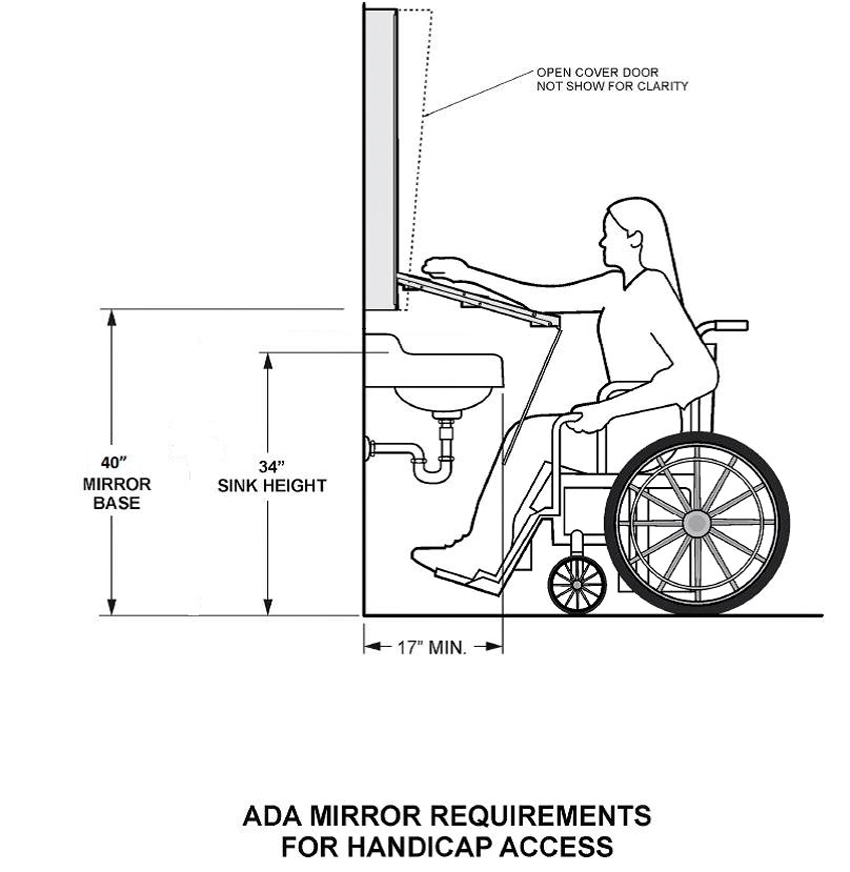
Image courtesy of AAMSCO Lighting
Maximum reaching height from a wheelchair is governed by the depth of a sink or other obstruction located between the person and the wall.
Hospitals and other health-care facilities have special considerations when it comes to the health, safety, and welfare of their occupants. Sanitation and cleanliness are of upmost importance. Residents and patients may be older or immune compromised, and thus more vulnerable to disease-causing pathogens than healthy people. In addition, health-care facilities often see a higher proportion of people with special needs when it comes to mobility and access. Care providers must be able to effectively perform their work. At the same time, the building design should ideally promote healing through design choices that create a warm and comforting environment. Finally, the building should be safe, secure, and easy to navigate.

Photo courtesy Courtesy of Cascade Architectural
Coiled wire fabric was used as a visual design element and safety feature around the elevator shaft and stairways at the VGM Group’s Iowa headquarters.
The transmission of infectious disease is a serious problem in hospitals and other health-care settings. The COVID-19 pandemic has underscored the importance of mitigating this risk while also maintaining flexibility. Sometimes spaces may need to be rapidly reconfigured to accommodate an influx of patients. At the same time, staff must help prevent the spread of highly infectious disease pathogens. Together, these concerns drive nearly every design choice, from floorplan design and layout to lighting design and the selection of surfaces, finishes, and fixtures.
DESIGN FOR QUALITY CARE AND PATIENT SAFETY
Designers of health-care facilities must balance many factors: the safety, health, and well-being of patients; the effective delivery of care; the creation of a welcoming environment that promotes healing; energy efficiency; and the cost of maintenance and operation, among others.
A literature review conducted by several researchers in 2007 identified several design elements as critical for ensuring patient safety and quality care. These include strategies that help prevent falls, reduce the risk of cross-contamination, and enhance visual performance, among others.
Let’s look at a few examples of design choices that enhance accessibility, safety, and health in health-care facilities.
Wheelchair-Accessible Medicine Chest
Wheelchair-accessible medicine chests and mirrors can make a significant difference for someone with a disability. These Americans with Disabilities Act (ADA)compliant products are ideal for assisted-living facilities. One such medicine chest is constructed with an angled, LED-illuminated mirror that allows people with a lower viewing level to see their reflection. It also allows access to medications without assistance by allowing the user to lower the interior shelving down to a comfortable level. This innovative design addresses equity and safety—two key concerns in health-care facility design.

Photo courtesy of AAMSCO Lighting
Safe, accessible medicine storage is important to the health and well-being of residents and patients in health-care facilities.
Copper-Clad Wire Fabric
Copper-clad wire fabric is an innovative product that can be incorporated into building interiors as part of an overall design scheme or to temporarily partition rooms. The material is lightweight and will not interrupt airflow, an important consideration for ensuring airborne pathogens do not build up within a space. The fabric consists of pure copper metallurgically bonded to the surface of low-carbon steel wire. Left in its natural state, copper-clad steel wire has demonstrated antimicrobial properties, reducing the risk of cross contamination and enhancing the safety of health-care facilities.

Photo courtesy of Cascade Architectural
Copper-clad wire fabric is naturally antimicrobial and can be used to divide spaces or provide solar and shade control.
Antimicrobial Privacy Curtains
Privacy curtains are often used to divide cubicles in emergency departments. Although single-patient rooms are preferred, privacy curtains are also used to provide privacy to patients who must share rooms. These frequently touched curtains can serve as a vector for disease organisms. However, fabrics that utilize silane-based technology have been tested and proven to be permanently antimicrobial and inhibit the growth of mold and mildew. These fabrics also repel liquids and are highly resistant to most stains.

Photo courtesy of Inpro
Privacy curtains can contribute to a safer, hygienic, and dignified health-care environment.
The rest of this course will consider design choices in several key categories: hygienic and accessible restrooms; the creation of hygienic, flexible, and healing interiors; materials and products that reduce the spread of contaminants via surfaces; and design choices for critical care environments.
HYGIENIC AND ACCESSIBLE HEALTH-CARE RESTROOMS
Restrooms offer a special challenge for health-care design. These rooms must be easy to clean and hygienic, but they also must be safe and accessible. Health-care facilities provide treatment for a higher proportion of people with physical challenges. These include physical disabilities as well as conditions such as obesity and age-related declines in vision and motor function. In addition, some patients and residences may suffer mental disorders that make them more prone to harming themselves.
As required by the ADA, all public buildings must be accessible for people with disabilities. This is especially important in hospitals and health-care facilities because they typically serve a much larger population of users with disabilities.
There are specific requirements for ADA-compliant restrooms that guide everything from how much weight certain fixtures must be able to bear to how much space must be allowed around fixtures. Architects and designers should also be aware that there is a trend in hospital design toward more “home-like” interiors. Colors, textures, and styles can impact patient comfort and well-being; this awareness is driving an aesthetic that feels more residential rather than institutional.
Accessible Medicine Storage
People who need health care usually need medications. Someone who is also wheelchair bound must be able to access these medications and other health-related items, such as bandages and toiletries. Many people typically store such items in a medicine cabinet over a sink. However, these cabinets are usually beyond the reach of someone in a wheelchair.

Image courtesy of AAMSCO Lighting
Maximum reaching height from a wheelchair is governed by the depth of a sink or other obstruction located between the person and the wall.
Identifying Standards
ICC ANSI 117.1 addresses sinks and wheelchair accessibility. It also addresses high and low reaching heights from a wheelchair and differentiates between unobstructed and obstructed reaching conditions. A medicine cabinet over a sink creates an obstructed situation. The 117.1 standard defines that obstruction since it defines the parameters for the sink in Section 606: Lavatories and Sinks. First, the required clear space in front of the sink is defined based on Section 305 and a forward approach, meaning that the person in a wheelchair is able to reach forward to access the sink. The sink itself is required to be no higher than 34 inches from the floor. An enhanced reach range is acknowledged if the sink is no more than 11 inches deep. If a more standard condition occurs where the sink is in a countertop that is approximately 17 to 24 inches deep, the reach range is not considered to be enhanced.
In terms of reaching something above the sink, Section 308: Reach Ranges is the applicable part of the 117.1 standard. Section 308.2.2 related to Obstructed High Reach points out that “the clear floor space complying with Section 305 shall extend beneath the element…” thus allowing full access by pulling forward to reach the wall above the sink. It goes on to indicate that there are two different high forward-reach height limits: a 48-inch maximum above the floor applies where the reach depth is 20 inches or less, while 44 inches is the maximum reach height if the depth exceeds 20 inches but up to a maximum of 25 inches.
In the case of providing an accessible medicine cabinet over a sink, the standard dictates that the bottom of that cabinet (and the access to anything in it) must fall between 34 inches above the floor (maximum sink height) and either 44 or 48 inches above the floor depending on the depth of the sink/counter. Where a mirror is on the face of the medicine cabinet, the bottom of the mirror is dictated in the 117.1 Standard in Section 603.3: Mirrors.
In this case, it requires it to “be mounted with the bottom edge of the reflecting surface 40 inches maximum above the floor.” This simply places the mirrored surface a bit closer to the sink height but does not change the maximum reaching height inside the medicine cabinet.
Providing Solutions
The accessible range of someone in a wheelchair is limited to approximately 10 to 14 inches of height above a sink—or less. That severely limits access to medications or other needed health products. Keeping in mind that every individual’s needs are different, solutions that emphasize flexibility and maximize accessibility usually serve the greatest number of people.
An excellent example of such innovation is found in a medicine cabinet now on the market that combines accessibility and ingenuity. This cabinet allows someone in a wheelchair to reach the bottom of the cabinet door above the sink and open it to reveal the contents inside. While normally someone would only be able to reach the bottom shelf of the cabinet, this design includes a vertically hanging handle that is connected to a cleverly designed shelf system that the user can pull easily downward. Individual shelves adjust with gravity as they are lowered, allowing all of the contents to remain on the shelf and be placed directly above the sink in front of the person. Hence, all of the contents of the cabinet are now accessible to the user. When done, the shelves are simply pushed back up into place and the door closed. This synchronized operation allows the user to act completely independently from the wheelchair without requiring assistance or standing.
In addition to this helpful functionality, the cabinet features a residential style and intentionally simple aesthetic. The medicine chest provides a clean-looking mirrored cabinet that is angled downward on the front so that wheelchair users can see themselves easily. The cabinet is also illuminated both on the outside and inside, providing light above the sink and easy visibility of the contents inside the chest.
Liz Congero, vice president of sales and marketing for Aamsco Lighting, notes the positive impact of this type of innovation, saying, “The overall net effect is that elderly or physically challenged people can remain in their homes or a long-term care facility and maintain a level of independence. This helps with a person’s well-being, which can also be linked to addressing concerns about having access to their medications without assistance.” This innovative solution combines accessibility and architectural design, providing a model for the types of features we should expect in today’s health-care facilities.
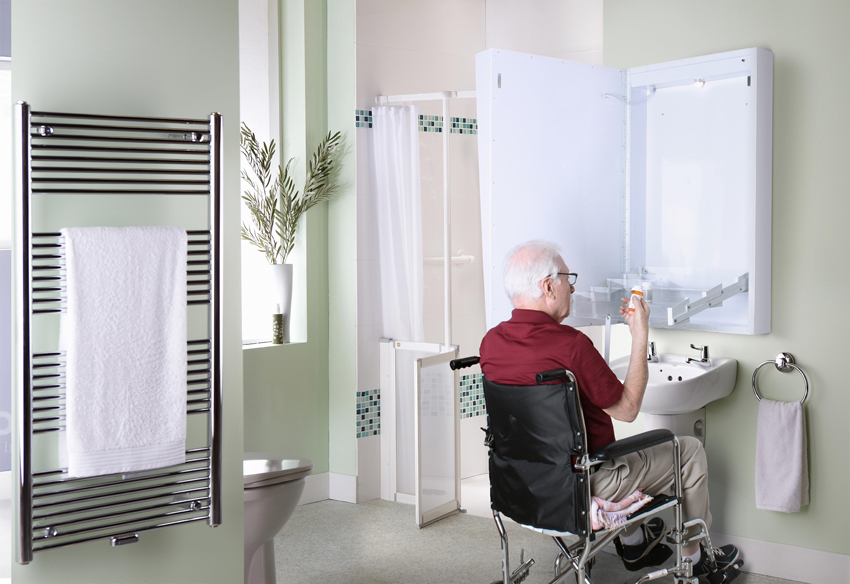
Photo courtesy of AAMSCO Lighting
This illuminated and mirrored medicine chest allows a wheelchair user to independently access medications and toiletries.
Solid-Surface Shower Surrounds and Pans
Showers in health-care facilities must be easy to clean, sanitary, and safe for the patients and residents who use them. Solid surface, typically made from a combination of acrylic and polyester resins, is an excellent material choice for shower surrounds and shower pans in health-care environments. Because the material is non-nutritive, it does not promote the growth of mold and mildew and resists bacterial growth. In addition, the inclusion of “active” antimicrobials within the solid surface can reduce odor-causing bacteria.
Solid surface has a huge advantage over tile, as it does not include grout, which is a favorite substrate for mold and bacteria. The material is also much easier to clean than grouted tile.
Designs can be routed into the solid surface to mimic the look of tile without compromising the material’s integrity. Designers can select smooth panels or, for a more residential aesthetic, choose from an array of decorative designs such as diamonds, subway tile, basic squares, and beadboard.
Receptors or pans made from solid surface can be poured into squares and rectangles of varying sizes. The integral non-skid surface helps prevent slips and falls, and ADA edges and ramps can ease the transition from floor to receptor. Drain locations can be set to match existing plumbing; trench drains are also an option.
Shower bases can be poured and fabricated into an almost unlimited array of custom shapes. In addition, factory-fabricated shower receptors ensure consistent quality and material performance through rigorous production standards.
Solid-surface products boast a long life cycle, reducing maintenance and replacement costs. The material is extremely durable and will not degrade. Most importantly, it looks new for a very long time.
Fabric Shower Curtains
Designers have several options when it comes to enclosing a shower. While new designs are incorporating doorless showers or glass doors, many facilities still have shower curtains for privacy. The right choice of curtain material can be enlisted to help keep mold and mildew in check.

Photo courtesy of Inpro
Solid-surface shower surrounds and antimicrobial curtains help maintain a cleaner environment, which boosts overall patient comfort and satisfaction.
Bio-static shower curtains resist mold and bacteria and are made from durable, multipurpose vinyl for easy cleaning and low maintenance. These curtains are also available in a variety of colors and styles and can contribute to the room’s aesthetic. ADA models feature a bottom lip and side Velcro seals to keep water in the shower area, which reduces the risk of slips and falls.
FLEXIBLE AND HYGIENIC INTERIORS
More than ever, health-care facilities must be able to accommodate fluctuating caseloads. At times, rooms may need to be partitioned to make the best use of space. Fortunately, there are solutions for changing the configuration of rooms that are not only hygienic and safe but also offer a pleasing aesthetic.
When partitioning a space, there are several factors to consider. The HVAC system has likely been designed to maintain airflow and ensure airborne pathogens do not accumulate. It is important that a partition does not block this important function. In some cases, it may also be important that the partition does not block access to light. Finally, it should not obscure wayfinding signage.
Although functionality and cleanliness are critical in health-care facilities, aesthetics play an important role in creating an appealing environment that promotes healing. Increasingly, these facilities are incorporating design elements that feel warm and welcoming rather than cold and sterile. Many of these elements also bring a touch of nature into the facility—a strategy which has been shown to promote well-being and healing and even reduce the length of hospital stays. This can be accomplished through a combination of elements, including finishes and flooring, partitions, curtains, wallcoverings, and lighting. Artificial lighting and daylighting in particular play a key role in illuminating a space and creating an appealing indoor environment in which to live, work, and heal.
Coiled Wire Fabric Panels
The COVID-19 virus outbreak has spawned an urgent need for medical capacity in many regions. There are many design situations where a need arises to provide a degree of separation for safety or different uses where a solid wall or partition is not needed. In fact, it may even be desirable to provide for some connectivity between spaces for visual, airflow, sound, or other considerations.
Coiled wire fabric panels are an excellent solution for partitioning spaces in health-care facilities. The panels can be used in common areas requiring wayfinding and to create temporary dividers or partitions for check-in stations.
Because the material is so flexible, panels can be straight, curved, or undulating, providing visual interest while performing their important function.
Coiled wire panels are comprised of a base metal wire that is typically available in varieties of steel, aluminum, brass, copper, or stainless steel. They are manufactured by interlocking metal wire coils via a simple corkscrew method; the spirals are woven together to create a flexible metal fabric panel. Panel edges are hand crimped, and the finished panel is secured to the attachment system. Both the wire material and its gauge impact weight, functionality, and aesthetics, so it is important to select these attributes with the project requirements in mind.
Architects and engineers can use coiled wire fabric in building interiors for curtains, ceiling treatments, wallcoverings, security gates, and even as complete partitions. They are available with a range of attachment systems, allowing for different building conditions and finish treatments.
Coiled wire fabric panels provide privacy and delineation, but the nature of the material allows light and air to pass through. This is a key consideration when partitioning rooms, especially in health-care settings. The HVAC system is designed to circulate air so that pathogens do not accumulate in a space. It is critical that partitions or curtains do not interrupt this function.
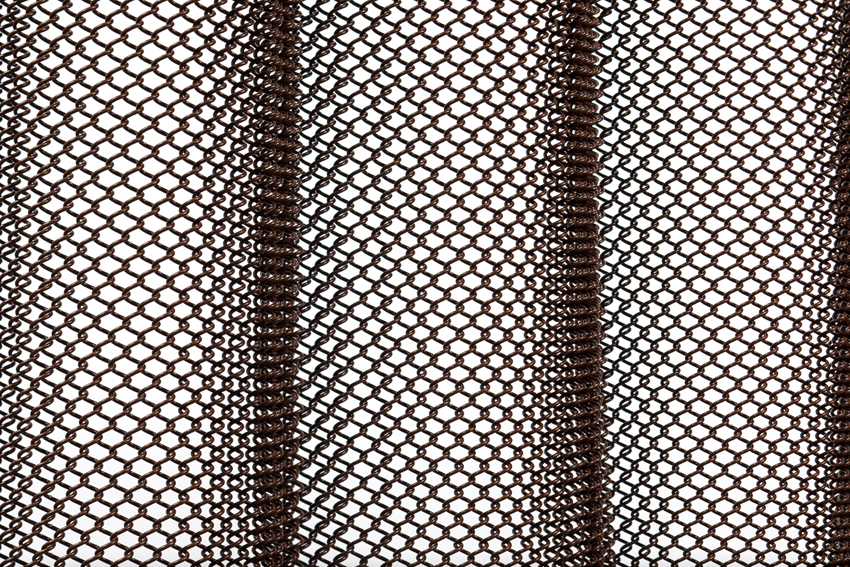
Photo courtesy of Cascade Architectural
The gauge and fullness of coiled wire fabric panels can be varied to achieve the desired visual effect.
Flexible Wall Protection
Walls in high-occupancy buildings endure continual wear and tear, whether it be from equipment and carts or pedestrian traffic. The most obvious type of impact is that which directly damages drywall, leaving cuts, gouges, or even holes. However, a more subtle form of damage accumulates more slowly in the form of scuffs, marks, and abrasions that eventually create a shabby, worn appearance.
An excellent solution for walls in health-care facilities is flexible wall protection, which combines the look of true wallcovering with the durability of rigid wall protection. This durable, resilient, and easy-to-clean material is available in many patterns, textures, and colors. The surface is nonporous, which makes it a hygienic solution for health-care facilities.
Flexible wall protection is made from vinyl, but it incorporates texture in the material for an appealing and interesting aesthetic. This wall protection is as thick as rigid products and will withstand moderate abuse. In addition, the panels are Class A fire rated.
Health-care facilities must be cleaned frequently and thoroughly, and fixtures, surfaces, and finishes must be able to withstand frequent treatment with strong, broad-spectrum bactericides and virucides.
Here are some of the standards and certifications to consider when specifying interior products:
- ASTM D-543 for chemical resistance; G-21 and G 22 for fungal and bacterial resistance
- AR CE CenterISO 846: Biological resistance and ISO 2812-1: Chemical cleanability
- AR CE CenterGREENGUARD certification for indoor air quality
Proper surface preparation and adhesive is critical to prevent mold behind flexible wall cladding. When tested for use with the U.S. Environmental Protection Agency's (EPA's) approved list of disinfectants, flexible wall protection products showed no change on the surface material or color following exposure to the cleaning agents, such as undiluted household bleach, isopropyl alcohol, and 3 percent hydrogen peroxide.
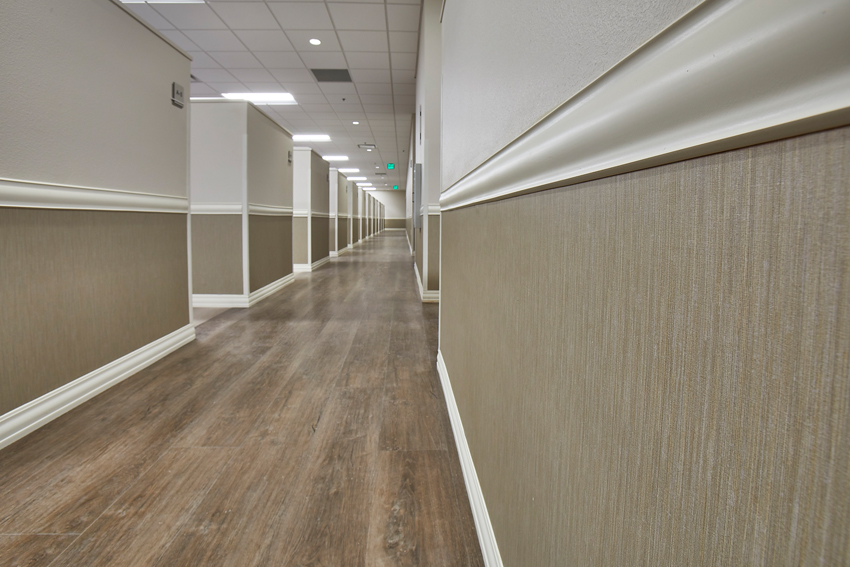
Photo courtesy of Inpro
Textured solid-surface wallcovering is durable and easy to clean, and it can impart a warm, residential feel to health-care facilities.
The Importance of Lighting in Residential Health-Care Settings
Lighting plays a critical role in health-care facilities. Good lighting design considers illumination levels, color temperature, and color rendering of artificial light sources; it balances ambient and task lighting and artificial and natural light. Effective lighting ensures health-care providers can perform their tasks and help keep patients, residents, and staff safe.
Residential facilities such as assisted-living facilities, nursing homes, and hospice care facilities have particular concerns. On average, residents in these facilities are in their 80s or older. People in this age group experience physiological changes that affect their vision, sleep patterns, and more.
Older people may have poorer vision and a decreased ability to detect color differences; at the same time, they may be more sensitive to glare. They may have trouble reading small print, distinguishing colors, and transitioning between bright and dim spaces. Eye diseases such as glaucoma and cataracts are also more common in this demographic. Degradation of sight and disorders such as Alzheimer’s disease and dementia can disrupt circadian rhythms, which govern sleep cycles and other physiological functions. Alzheimer’s can negatively affect depth perception and peripheral vision. People suffering from Alzheimer’s may not be able to discern brightness contrast, and they may be more sensitive to glare and shadows. These deficiencies can contribute to falls and reduced balance and stability.
Lighting design for long-term care facilities typically emphasizes daylight and higher electric light levels, minimizing glare through indirect light distribution and other means, good uniformity of light distribution, and accent lighting for safety. Transition spaces receive high illumination for visual adaptation. Flicker should be avoided. At the same time, these facilities are not just clinical environments but residences. Consequently, lighting should support the body’s inherent biological circadian rhythms, which depend in part on light and dark cycles. In addition, both the light quality and lighting fixtures should be promote a sense of comfort and “hominess.”
Several standards guide lighting design in health-care facilities. IES RP-28 sets minimum recommended light levels, while the ADA sets limits for how far light fixtures may project from a wall. The Facility Guidelines Institute (FGI) require daylighting in common areas such as dining and activity rooms, while recommending it wherever else possible based on its value for light levels, color quality, and circadian entrainment. The guidelines add that if daylight is not available, electric lighting should promote circadian response, which may be accomplished with intensity and color control in LED luminaires.
LED lighting technology has opened up new possibilities for lighting design that supports health. LEDs can produce “white” light in a range of color temperatures; in addition, newer LEDs have improved color rendering, which is a measure of how they appear under artificial lighting compared to natural light.
Recent studies also underscore the promise of biodynamic LED lighting. Such lighting supports the body’s natural circadian rhythms by mimicking the color temperature and intensity of light as it cycles through the day. “Circadian-friendly” lighting may improve sleep by ensuring adequate levels of “blue” light during the day. This helps regulate the production of melatonin, a key sleep hormone.
ANTIMICROBIAL MATERIALS AND SURFACES
Both airborne and waterborne transfer of germs and bacteria are of great concern in health-care settings. However, infectious organisms can also be transferred indirectly through our hands. When an infected person touches a wall, curtain, door handle, or piece of equipment, they may deposit bacteria on that surface. A healthy person may come into contact with the infectious bacteria when they touch the same surface. From there, the bacteria may be transferred to something the non-infected person eats or drinks, or it may enter the body when that person rubs their eyes or nose.
Frequent handwashing is often promoted as the best way to protect against infection; however, this practice requires constant diligence and access to handwashing facilities. Hence, finding ways to control or eliminate the spread of diseases is an increasing priority in hospital settings as well as other high-occupancy buildings, particularly where vulnerable populations may be present. These include retirement communities, assisted living facilities, spa/wellness centers, schools, and other public buildings.
One way to combat the transmission of these diseases is to reduce the amount of time that bacteria or viruses can survive on surfaces that people touch. This can be accomplished by specifying antimicrobial materials and products.
The term “antimicrobial” is used to generically describe materials or products that have been shown through testing to kill or stop the growth of bacteria and other microorganisms. Specifying materials with antimicrobial properties for touchable surfaces is a prime strategy for stopping or slowing the spread of disease-carrying germs in health-care facilities.
Copper-Clad Wire Fabric
Copper-clad wire fabric is an innovative product that can be incorporated into building interiors as part of an overall design scheme and for its demonstrated antimicrobial properties. This fabric consists of pure copper metallurgically bonded to the surface of low-carbon steel wire. It is extremely durable and contributes a distinct and beautiful aesthetic. Copper-clad wire exhibits a brilliant red polished finish when extruded in a continuous solid-cladding process. However, if left bare and untreated, the wire’s appearance will evolve over time, taking on brownish hues and ultimately a grey-green patina. Left in its natural form, copper-clad steel wire is naturally antimicrobial and can enhance public safety where it is installed. (Applying a thin layer of clear automotive lacquer can help maintain the bright salmon color; however, this finish may reduce the material’s antimicrobial effects.) Copper-clad wire conforms to ASTM standards for both interior and exterior applications and is available in a wide variety of wire gauges.
Antimicrobial Properties of Copper
Copper, whether in pure form or in an alloy such as brass, bronze, or copper-nickel alloy, naturally has antimicrobial properties. For millennia, these metals have been attributed with reducing illness, although our understanding of germs and bacteria as the cause of such illnesses is a much more recent development.
The scientific research on the antimicrobial effects of copper suggests that it affects bacteria in two sequential steps. First, the copper surface directly interacts with the outer membrane of the bacteria cell, causing the membrane to rupture. Once ruptured, the cell loses vital nutrients and water, causing a general weakening of the cell and finally killing off the bacteria altogether.
Antimicrobial products marketed and sold in the United States are regulated by the EPA to ensure the products are safe to use. Advertising claims about protecting public health and efficacy against specific pathogens must be supported by rigorous testing under EPA-approved protocols. For example, a product or material must demonstrate that it continuously kills more than 99.9 percent of bacteria within 2 hours of contact between routine cleanings. Copper alloy materials are registered by EPA (Reg. Nos. 82012-1 to 6) to make public health claims against six specific bacteria:
- E. coli O157: H7, a food-borne pathogen that has been associated with large-scale food recalls;
- Methicillin-Resistant Staphylococcus aureus (MRSA), one of the most virulent strains of antibiotic-resistant bacteria and a common culprit of hospital- and community-acquired infections;
- Staphylococcus aureus, the most common of all bacterial staphylococcus (i.e., staph) infections that can cause life-threatening diseases, including pneumonia and meningitis;
- Vancomycin-resistant Enterococcus faecalis (VRE), an antibiotic-resistant organism responsible for 4 percent of all HAIs;
- Enterobacter aerogenes, a pathogenic bacterium commonly found in hospitals that causes opportunistic skin infections and impacts other body tissues;
- Pseudomonas aeruginosa, a bacterium that infects the pulmonary tracts, urinary tracts, blood, and skin of immune-compromised individuals.
While copper has been shown to be very effective at killing these six specific bacteria, it should be noted that at this time, there is very limited information and testing available on COVID-19 or other similar coronavirus microbes.
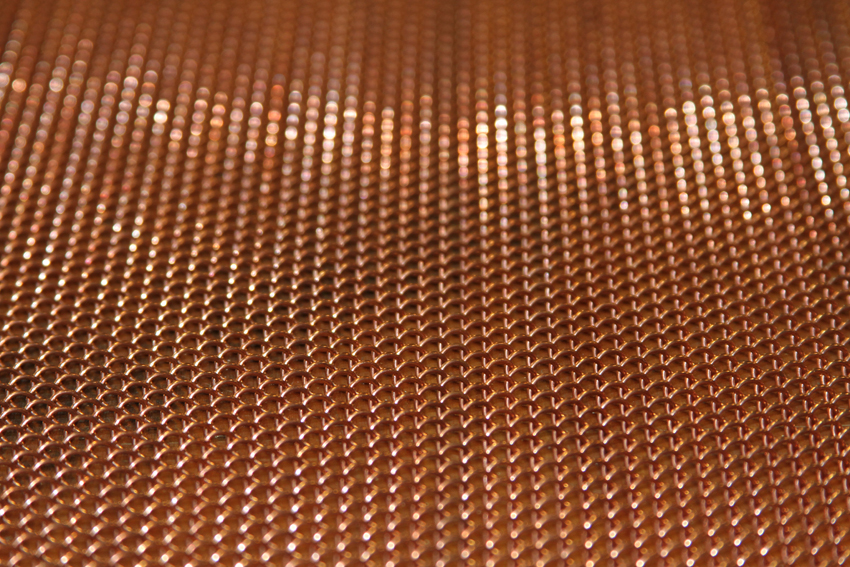
Photo courtesy of Cascade Architectural
Copper is naturally antimicrobial and, where used, may help reduce the transmission of certain pathogens from surfaces.
Hygienic Privacy Curtains
Privacy curtains are essential for protecting the privacy and dignity of patients in health-care settings. They are used in emergency departments, private rooms, and elsewhere, and are an essential tool for rapidly reconfiguring a space. The selection of colors and textures can help create a warm and welcoming environment for patients, residents, visitors, and staff. However, these fabric curtains are also a prime vector for contamination, as they are touched frequently by many different people. They also require laundering, unlike counters or medical devices.
Although frequent changing and washing of these curtains can help reduce the incidence of cross contamination, as can practicing good hand hygiene, the risk cannot be completely eliminated.
Selecting easy-to-clean fabrics with antimicrobial properties can reduce the risk further. Fabrics that utilize silane-based technology have been tested and proven to be permanently antimicrobial and inhibit the growth of mold and mildew. These fabrics also repel liquids and are highly resistant to most stains. These properties make them ideal for cubicle curtains, shower curtains, and window treatments.
One hospital in New York did a room turnaround analysis and determined that by using antimicrobial fabric curtains, they could speed the changeover and save the hospital $50,000 in the first year and $140,000 in each subsequent year. The savings derived from lower laundering costs, change-out time, and reduced loss in revenue due to room closures.
Another option that utilizes the same antimicrobial fabric is snap-panel curtains, which allow easy change-out of only the soiled panels. Standard panel sizes are 66 inches wide by 66 inches high; custom sizes are available. These panels easily snap into place and can be configured to any length. No ladder is needed, which reduces the risk of strains and falls.
There are some cases where disposable curtains might be the best options. These are typically made from 100 percent woven polypropylene and include a polyester mesh and Velcro tie back. Be sure to select disposable curtains that have passed the NFPA 701 Fire Retardant Test.
Analysis shows that disposable privacy curtains over time can cost as much as 70 percent more than washable curtains. However, disposable curtains may be a better alternative in spaces where frequent change-outs are the norm. Environmental services and maintenance staff must weigh their options when it comes to privacy curtains. They may switch to disposable curtains, stay with washable curtains, or employ a mixed strategy and utilize disposable curtains for some applications and washable curtains for others.
SOUND CHOICES FOR CRITICAL CARE ENVIRONMENTS
Critical care environments have special design concerns. Portions of a hospital that provide critical care include intensive care unitss (ICU), labor and delivery units, surgical ICUs, trauma ICUs, and many others.
Each of these has very specific patient needs, and the design of these spaces has important implications for safety, well-being, and the delivery of care. For example, some patients may be experiencing delirium. Others may be recovering from stroke; they likely have limited mobility and may require in-room cameras to spot seizures and other issues. All of these concerns must be factored into the design of the space.
Lighting must be adequate for performing critical tasks while reducing fatigue among health-care workers. Finishes and surfaces must be durable and resistant to bacteria. And the environment should be soothing and help make the experience less stressful for the patient.
Now we willll take a look at some specific examples of design choices for critical care environments.
Solid-Surface Wall Cladding
Solid-surface wall cladding is an excellent and durable solution for spaces like operating rooms and other sterile environments. The material is made from acrylic and/or polyester resins combined with filler, color pigments, and acrylic chips. The material is typically extruded or poured; it can also be molded while hot.
Since solid surface is non-nutritive, it does not promote the growth of mold and mildew, and it resists bacterial growth. The inclusion of “active” antimicrobials within the solid surface can also reduce odor-causing bacteria.
Many colors and particulate combinations available. Most manufacturers offer complementary accessories such as corner molding, batten strips, and perimeter trim for a cohesive appearance.
Solid surface is nonporous and extremely durable. It has a long life cycle, which helps with its environmental footprint and helps keep maintenance and operation costs down.
In construction projects, especially major renovations or retrofits, installers may encounter wall conditions that are less than true. Specifying solid-surface panels with an S-curve “wavy” edge allows panels to fit together with a flat, flush seam where the wall may fluctuate.
This has important implications for hygiene. The tight, flush, hard seam reduces places where dirt, dust, mold, and germs can get trapped. Some solid-surface panels are produced in larger-than-standard industry size, which can also reduce the number of seams in a wall run.
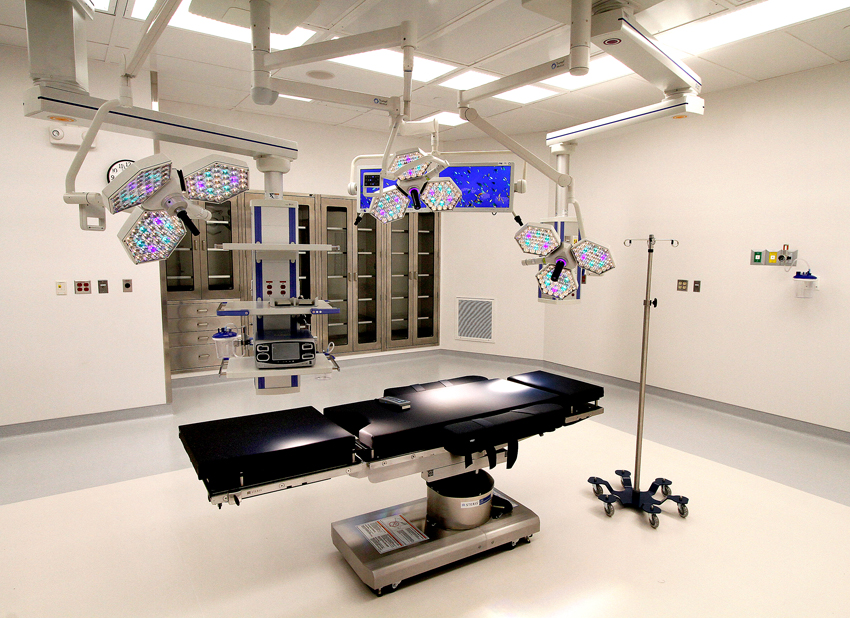
Photo courtesy of Inpro
Durable, nonporous solid-surface panels are an excellent choice for critical care environments, and they can be accessorized with trim and molding.
Critical Care Lighting Solutions
Lighting for critical care units must be designed for patient and caregivers alike. It must provide high-quality illumination for critical care and labor and delivery settings, but it must also help patients feel comfortable.
One in-ceiling lighting system demonstrates how a single system can meet both of these goals. The system features a low-profile style that helps patients feel more comfortable, while the high-quality illumination provides the caregiver with the ability to adjust the light intensity level for clinical care needs.
This system provides the ideal intensity and fixed spot for exam, suturing or minor procedures. Cool, color-corrected lighting renders skin tones and textures more accurately. Easy-to-use wall-mounted controls allow the caregiver to focus on the patient. Each fixture is independent and can be quickly and easily controlled. The recessed fixtures provide an uncluttered environment, which helps reduce stress for both the patient and the caregiver.
CONCLUSION
Health-care design can help mitigate the risk of infection and HAIs while ensuring patient accessibility, safety, and well-being. Good design can also support the vital work that health-care workers perform, and help cultivate a welcoming and healing environment for patients, residents, visitors, and staff. As this course has shown, architects and designers play a key role in ensuring health-care facilities meet all of these goals through the specification of finishes and surfaces, fixtures, and lighting products, among many others.
Juliet Grable, is an independent writer and editor focused on building science, resilient design, and environmental sustainability. She contributes to continuing education courses and publications through Confluence Communications. www.confluence.com













